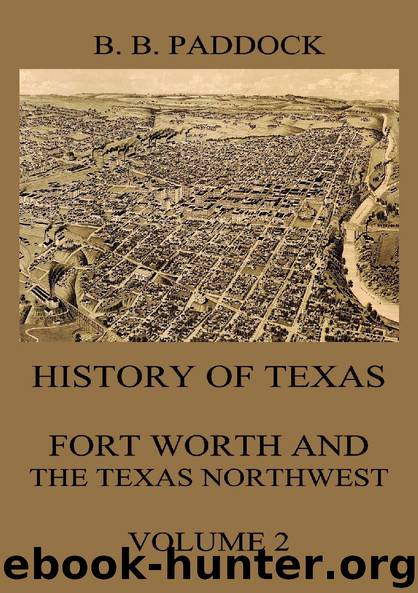History of Texas: Fort Worth and the Texas Northwest, Vol. 2 by Buckley B. Paddock

Author:Buckley B. Paddock [Paddock, Buckley B.]
Language: eng
Format: epub
Tags: Geschichte
Publisher: Jazzybee Verlag
Published: 2017-10-12T22:00:00+00:00
The republicans nominated George W. Burkhart, of Anderson County, for governor. The populists nominated J. M. Mallett and the prohibitionists, G. W. Carrow. At the ensuing election the democratic ticket received 269,676 votes, the republican 65,916, the populists 12,387 and the prohibitionists 8,768 votes.
The most prominent legislative enactment during Governor Lanham’s term was the passage of the intangible assets law, by which a commission composed of state officers were authorized and empowered to assess against the several railroads of the state such an amount as, in their judgment, was just and equitable and represented the value of their franchises separate and apart from their tangible property. To this was added the market value of outstanding bonds and stocks, thus converting a liability into an asset. This law was hotly contested by the railroad corporations in the courts of the state, but was finally decided to be constitutional.
In 1904 Lanham and Neal were renominated for governor and lieutenant-governor, respectively, and J. G. Lowden, of Taylor County, and Sam Davidson, of Tarrant County, were nominated by the republicans for the offices of governor and lieutenant-governor, respectively. At the ensuing election the democratic ticket received 167,200 votes, the republican ticket, 51,242 votes.
The second administration of Governor Lanham was marked by conservatism and without any feature of unusual public interest.
There was a spirited pro-convention contest in 1906, at which Thomas M. Campbell, of Anderson County; O. B. Colquitt, of Dallas County; C. K. Bell, of Tarrant County, and S. P. Brooks, of McLinnan County, were the candidates.
It was soon apparent that the following for Mr. Brooks was in pronounced minority. It was not thought that his name would be put before the convention, but the delegate who had been selected to make the convention speech in behalf of Brooks insisted on placing him before the convention. On the first ballot Campbell led by a very large plurality, and Colquitt withdrew from the race. A second ballot between Campbell and Bell resulted in the nomination of Campbell.
A. B. Davidson was nominated for lieutenant-governor and R. V. Davidson for attorney-general. The republicans nominated Cary A. Gray for governor. At the following election Campbell received 283,942 votes and Gray, 42,169 votes.
Campbell’s administration was productive of more legislation of a general nature than had been witnessed in Texas for a number of years. Among the innovations advocated and carried into effect was a diversion of a large sum of the permanent school fund for the construction of a state railway from Palestine in Anderson County to Rush in Cherokee County, in which latter place was a branch of the Texas penitentiary and an iron deposit which had been promoted and operated with indifferent success for a number of years. Arguments of the proponents of this innovation were that it would afford transportation of the products of the penitentiary and be instrumental in the further development in the iron mines. The railway has been a stupendous failure from its inception up to date. Every year has shown large and increasing deficits, which had to be met from the general revenue of the state.
Download
This site does not store any files on its server. We only index and link to content provided by other sites. Please contact the content providers to delete copyright contents if any and email us, we'll remove relevant links or contents immediately.
| Africa | Americas |
| Arctic & Antarctica | Asia |
| Australia & Oceania | Europe |
| Middle East | Russia |
| United States | World |
| Ancient Civilizations | Military |
| Historical Study & Educational Resources |
The Body: A Guide for Occupants by Bill Bryson(4974)
Liar's Poker by Michael Lewis(3369)
Into Thin Air by Jon Krakauer(3312)
Tuesdays With Morrie by Mitch Albom(2695)
Into the Wild by Jon Krakauer(2582)
The Diamond Cutter by Geshe Michael Roach(2018)
My Dark Places by James Ellroy(1881)
Columbine by Dave Cullen(1815)
Helter Skelter: The True Story of the Manson Murders by Vincent Bugliosi & Curt Gentry(1699)
Extraordinary, Ordinary People by Condoleezza Rice(1468)
Everything in Its Place by Oliver Sacks(1445)
Pilgrim at Tinker Creek by Annie Dillard(1390)
Into the wild by Jon Krakauer(1383)
You Can't Touch My Hair by Phoebe Robinson(1360)
The Girls: Sappho Goes to Hollywood by Diana McLellan(1281)
Dark Towers by David Enrich(1205)
Betrayal by Gregg Olsen(1202)
Call Sign Chaos by Jim Mattis & Bing West(1185)
The Letters of Allen Ginsberg by Allen Ginsberg(1113)
